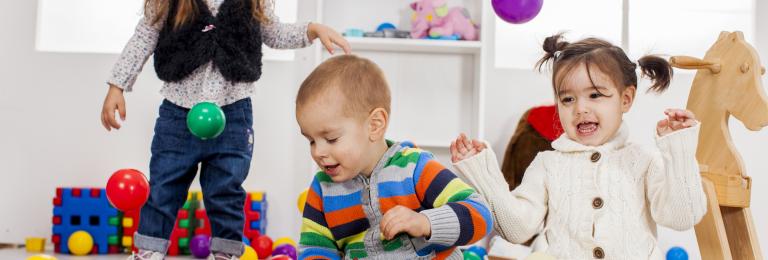Facilitating a Positive Physical Activity Environment
The physical layout of an environment can affect how active children are, the types of activities they do and the amount they move their bodies. Here are some practical equipment and space oriented tips for creating a positive space at your centre.
Create a space in the childcare setting (outside and inside) where physical activity is always allowed
- Try clearing an area in your classroom where it is always safe for kids to be active. Remove obstructions or breakable materials and cover the floor in soft padding.
Create a physical activity plan
- Work on scheduling physical activity into your daily schedule and be sure to stick to this schedule. Plan how you might alter the space; get equipment ready and clean up. Adding short bursts of activity throughout the day to your schedule is also a good strategy. This is also a good way to ensure that you practice all three fundamental movement skills – balancing, locomotion and coordination.
- Check out the ATP physical activity planning tool here.
Develop some back-pocket ideas
- Coming up with games on the spot is tricky. Try to come prepared with four to six easy, low-equipment games that can easily be played to fill some down time or if a planned activity is unsuccessful. Use the Appetite to Play website for some great ideas. Click here to see more.
- Here is a link to a mobile app from ParticipACTION that has some great on-the-go ideas.
Avoid overloading or cluttering physical activity space
- Set out specialized equipment just before it is to be used. Provide children with options for equipment, but do not make all of your equipment available every day. This helps to encourage children to be creative.
Variety, variety, variety
- Preschoolers are often active in short, high intensity bouts, so switching activities often is crucial. Further, switching the activities you do in a weekly rotation is also important. Replaying favourite games is a great way to promote enjoyable physical activity, but try to add elements to games to increase the challenge or skills necessary to play the game.
- Equipment variety is also important. Switch up what is available for unstructured physical activity each day. Remember, physical activity equipment doesn’t have to be official gear – large boxes, long rolls of paper, or ribbons can stimulate physically active play. Be creative.
- Try playing favourite games in new locations, such as in a field or at the playground.
Adapted from Occupational Therapy Now (Canadian Association of Occupational Therapists, March 2005) and Healthy Schools (Ontario Education, 2006).
